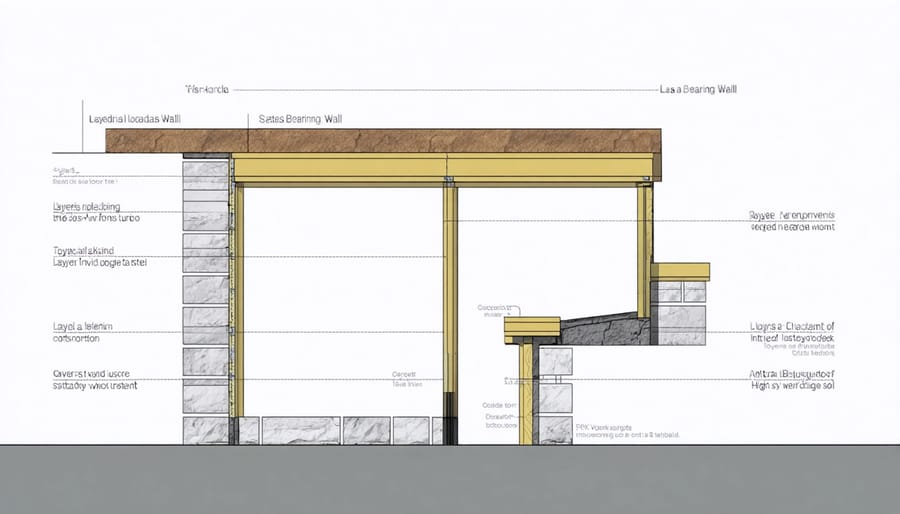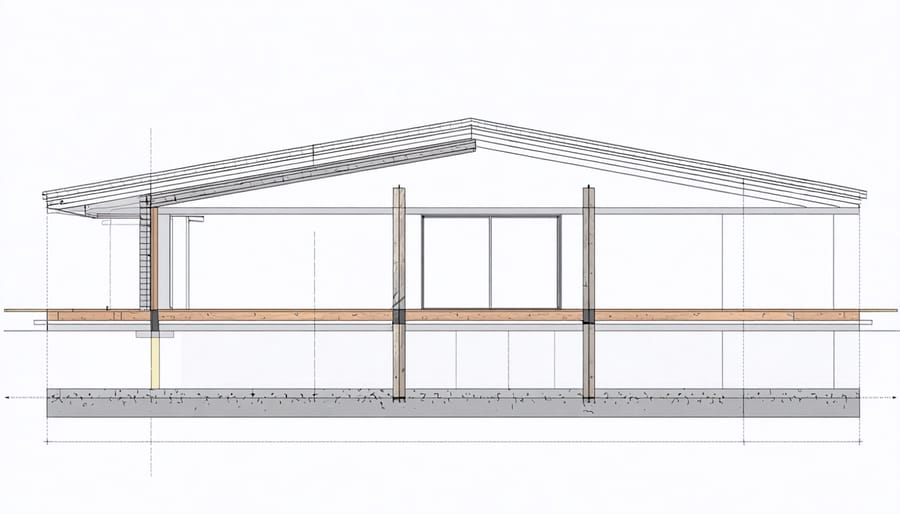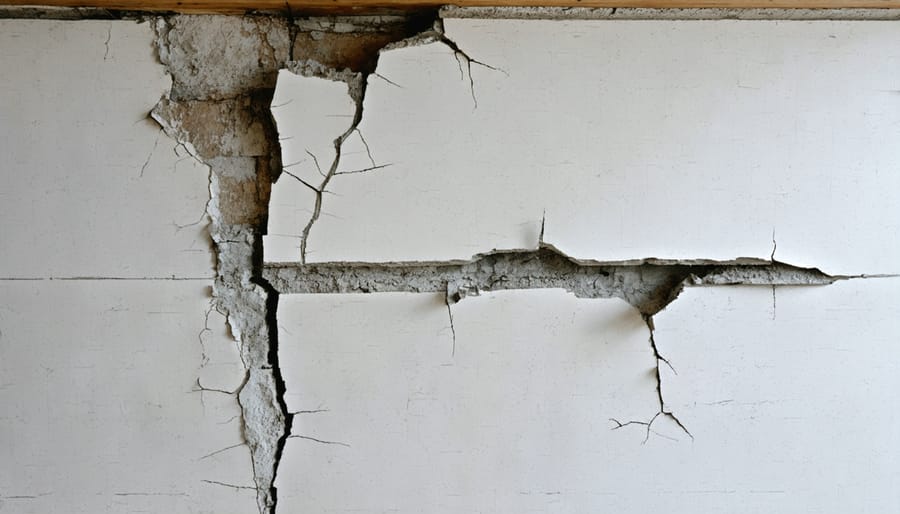Load-bearing walls form the essential skeletal structure of your home, supporting everything from the roof to upper floors. Understanding these critical architectural elements isn’t just about preserving your home architecture styles – it’s about ensuring safety during any renovation project.
Identify load-bearing walls by looking for continuous vertical support from foundation to roof, typically running perpendicular to floor joists. In multi-story homes, these walls usually stack directly above each other, creating a solid chain of support from top to bottom. Unlike decorative walls, they’re often built with stronger materials and additional reinforcement, featuring doubled-up studs, headers above openings, and thicker foundations beneath.
Before removing or modifying any wall, consult structural blueprints or hire a professional engineer to evaluate its role in your home’s support system. Even seemingly minor modifications to load-bearing elements can compromise your entire structure’s integrity, leading to sagging floors, cracked walls, and potentially catastrophic failure. Understanding these fundamental principles helps protect your investment while ensuring safe and successful home improvements.
What Makes a Wall Load-Bearing?

Key Indicators of Load-Bearing Walls
Identifying a load-bearing wall doesn’t have to be a mystery. Here are several reliable indicators that can help you spot these crucial structural elements in your home.
First, look at your home’s foundation. Walls that run perpendicular to your floor joists (the horizontal beams supporting your floor) are typically load-bearing. In basements or crawl spaces, any wall sitting directly on the foundation is almost certainly carrying weight from above.
Pay attention to wall position and construction. Load-bearing walls often run through the center of the house and extend through multiple floors in a straight line. These walls are usually thicker than non-load-bearing walls and feel more solid when you knock on them.
The location of major structural features can also provide clues. Walls positioned under heavy elements like roof beams, floor girders, or other major support structures are likely load-bearing. Similarly, walls that support ends of joists or contain multiple studs around doorways and windows typically carry structural weight.
In multi-story homes, walls that stack directly above each other from floor to floor are usually load-bearing. Also, exterior walls are almost always load-bearing, as they support both the roof and their own weight.
Remember, these are general guidelines, and it’s always best to consult a structural engineer before making any modifications to walls you suspect might be load-bearing.
Common Misconceptions
Let’s clear up some common misconceptions about load-bearing construction that often lead to confusion and costly mistakes. First, not all interior walls are load-bearing – a frequent misunderstanding that can unnecessarily limit renovation plans. In fact, many interior walls serve purely as room dividers and can be safely modified or removed with proper planning.
Another widespread myth is that brick or concrete walls are always load-bearing. The truth is that the material alone doesn’t determine a wall’s structural role. Even lightweight materials like wood can be essential support elements, while some masonry walls are purely decorative.
Many people believe that walls running parallel to floor joists can’t be load-bearing. This isn’t always true – these walls might support loads from upper floors or roof structures. Similarly, there’s a misconception that load-bearing walls must run the entire height of a building. In reality, some may only support specific sections or floors.
Perhaps the most dangerous myth is that small modifications to load-bearing elements won’t affect structural integrity. Even minor changes can significantly impact a building’s stability. It’s also wrong to assume that identifying load-bearing elements is a simple DIY task – while there are telling signs, proper identification often requires professional expertise to ensure safety and structural integrity.
The Critical Role of Load-Bearing Construction
Weight Distribution Basics
Think of your home as a team where every member plays a crucial role in supporting the whole structure. In modern structural design, weight distribution follows a simple yet fascinating path from top to bottom.
Starting at your roof, the weight of snow, rain, and the roofing materials themselves pushes downward. This force travels through your rafters and ceiling joists, which work together like a well-choreographed dance to spread the load evenly. The weight then moves into your walls – specifically the load-bearing ones – which act like sturdy columns in a ancient temple.
These walls transfer the weight into your floor joists, which distribute it across multiple points rather than concentrating it in one spot (imagine spreading out on snowshoes rather than walking in regular boots). Finally, all this weight reaches your foundation, which spreads the load into the ground beneath your home.
Understanding this flow of forces helps you appreciate why certain walls can’t be removed without proper support and why maintaining each structural element is crucial for your home’s stability.

Supporting Elements
Supporting elements are the unsung heroes of any sturdy structure, working together like a well-orchestrated team to distribute weight and maintain stability. Following traditional building techniques, these components include beams, joists, headers, and columns, each playing a crucial role in your home’s structural integrity.
Beams are the heavyweight champions, spanning across spaces to support floors and ceilings above. They’re typically made of solid wood, engineered lumber, or steel, depending on the load requirements and span distance. Working alongside beams are joists – smaller but equally important members that run perpendicular to the beams, creating a sturdy framework for your floors and ceilings.
Headers are special beams that span openings like windows and doors, redistributing the weight around these vulnerable points. They’re essential for maintaining structural integrity while allowing for practical living spaces. Meanwhile, columns and posts provide vertical support, transferring loads from upper floors directly to the foundation.
Think of these elements as your home’s skeleton – they need to work in harmony to keep everything standing strong. During any renovation project, it’s crucial to identify and protect these supporting elements to maintain your home’s structural safety.
Working with Load-Bearing Structures
When to Consult Professionals
While DIY projects can be rewarding, when it comes to load-bearing structures, knowing when to call in the professionals is crucial for your safety and home’s integrity. Always consult structural engineers or licensed contractors before making any modifications to walls, especially when your home renovation considerations involve potential load-bearing elements.
Seek professional help immediately if you notice:
• Cracks in walls, especially those that are wider at the top
• Doors or windows that suddenly become difficult to open or close
• Sagging floors or visible beam deflection
• Cracks in the foundation or exterior walls
• Uneven gaps between walls and ceilings
Additionally, always contact experts before:
• Removing or modifying any walls
• Creating new openings for windows or doors
• Installing heavy fixtures or appliances in upper floors
• Adding significant weight to your attic
• Planning major renovations that affect multiple rooms
Remember, structural engineers can provide detailed assessments and written reports, which are often required for permits and insurance purposes. While consultation fees might seem expensive initially, they’re a small price compared to the potential costs of structural failure or incorrect modifications. Don’t hesitate to get multiple professional opinions, and always work with licensed contractors who understand local building codes and regulations.
Safe Modification Options
While load-bearing walls are crucial for structural integrity, there are several safe ways to modify your space without compromising stability. The key is proper planning and professional guidance. Here are some tried-and-tested modification options:
Installing archways or larger openings is possible with the right support system. A qualified contractor can install steel beams or headers above the opening to redistribute the weight effectively. This popular modification can create an open-concept feel while maintaining structural integrity.
Adding pass-through windows between rooms is another less invasive option. These smaller openings require minimal structural modification and can significantly improve flow and light between spaces. They’re particularly effective between kitchens and dining areas.
For those seeking to create more storage, shallow recessed shelving can often be safely carved into load-bearing walls. The key is keeping the depth minimal (usually no more than 4 inches) and ensuring proper reinforcement around the cavity.
Remember that any modification to a load-bearing wall requires:
– Professional structural assessment
– Building permits and inspections
– Temporary support during construction
– High-quality materials rated for structural use
– Expert installation of support beams
Small cosmetic changes like adding wall sconces, hanging artwork, or installing shelving are generally safe as long as you use appropriate anchors and avoid deep drilling. When in doubt, always consult a structural engineer before making any modifications to load-bearing elements.
Warning Signs of Structural Issues
Being able to spot potential structural issues early can save you from costly repairs and ensure your safety. Keep an eye out for these telltale signs that might indicate problems with load-bearing elements in your home.
Cracks in walls, especially those that run diagonally, should never be ignored. While hairline cracks are common and often harmless, cracks wider than 1/4 inch or those that grow over time warrant immediate professional attention. Pay special attention to cracks that appear above doorways or windows, as these areas are particularly vulnerable.
Doors and windows that suddenly become difficult to open or close might indicate foundation movement affecting your load-bearing walls. Similarly, uneven floors or noticeable sagging in your ceiling should raise red flags. Look for gaps between walls and ceilings, or between walls and floors – these could suggest structural shifting.
Listen to your house, too. Creaking or popping sounds, particularly when walking across floors or during temperature changes, might signal joists or beams under stress. In basements and crawl spaces, check for wooden support posts that show signs of rot, splitting, or water damage.
If you notice any of these warning signs, don’t panic, but don’t delay either. Contact a structural engineer or qualified contractor for a professional assessment. Remember, catching these issues early often means simpler, less expensive solutions.

Home Maintenance Tips
Regular maintenance of your load-bearing structures is crucial for the long-term safety and stability of your home. Here are some essential tips to help you maintain these vital components:
Keep an eye out for warning signs such as cracks in walls, especially those that appear suddenly or grow larger over time. While hairline cracks are common in homes, any crack wider than 1/4 inch warrants professional inspection. Pay particular attention to cracks that run diagonally from corners of doors or windows.
Monitor your floors for signs of sagging or unevenness. Place a marble on the floor – if it rolls on its own, this might indicate a structural issue that needs attention. Check for squeaking floors or visible gaps between the floor and baseboards, as these can signal potential problems with floor joists.
Ensure proper moisture control around load-bearing walls. Keep gutters clean and functioning, and maintain proper drainage away from your home’s foundation. In basements and crawl spaces, use dehumidifiers to prevent excess moisture that could compromise wooden support structures.
Regularly inspect visible beams and posts for signs of water damage, rot, or pest infestation. Look for discoloration, softness, or small holes that might indicate termite activity. If you spot any concerning signs, contact a structural engineer immediately.
Never make modifications to load-bearing elements without proper permits and professional guidance. This includes avoiding drilling large holes in load-bearing walls or cutting into floor joists for new plumbing or electrical work.
Schedule professional inspections every 3-5 years to catch potential issues before they become serious problems. This preventive approach can save you significant money and stress in the long run.
Understanding load-bearing construction is crucial for maintaining the safety and integrity of any building. Throughout this guide, we’ve explored how these essential structural elements work together to support your home and keep it standing strong. Remember that load-bearing walls, beams, and columns aren’t just construction features – they’re the backbone of your living space.
As a homeowner or DIY enthusiast, knowing how to identify load-bearing elements and understanding their importance can save you from costly mistakes and potential safety hazards. Always prioritize professional consultation before making any structural changes, and never assume a wall is non-load-bearing without proper verification.
Regular maintenance and inspection of load-bearing elements are vital for your home’s longevity. Watch for warning signs like cracks, sagging, or unusual noises, and address any concerns promptly. When planning renovations, take time to research and understand how your proposed changes might affect the structural integrity of your home.
Whether you’re buying a new home, planning a renovation, or simply wanting to better understand your living space, this knowledge empowers you to make informed decisions. Remember that while DIY projects can be rewarding, some tasks are best left to qualified professionals, especially when it comes to structural modifications.
By respecting and properly maintaining your home’s load-bearing elements, you’re not just protecting your investment – you’re ensuring a safe and stable living environment for years to come.
